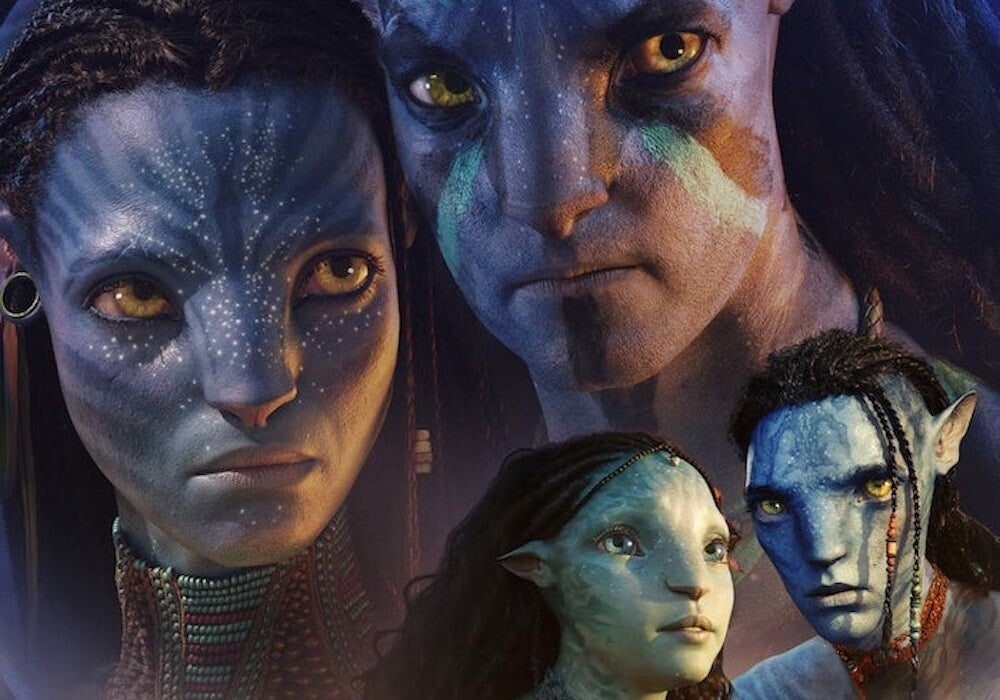Fourteen years after the original film, James Cameron's Avatar: The Way of Water is nearly just as much of a phenomenon. Grossing over $2 billion worldwide, it is now the top film of the "COVID era." Both are (too) long epics filled with understated and brilliant 3-D, impossibly beautiful landscapes, and a fairy tale-like story.
Like the first one, The Way of Water heavy-handedly explores subjects like colonialism and conservation—making it clear that the Earthlings are the bad guys—while simultaneously being criticized for cultural appropriation and the glorification of the military industrial complex. As The New Yorker's Anthony Lane writes of this dichotomy in Cameron’s film: "It’' as if Sir David Attenborough divided his time between birds of paradise and monster trucks."
Synopsis
The plot of The Way of Water is extremely simple considering its 192-minute runtime. The Na'vi, the blue-tinged cat-like humanoids that live in perfect harmony with nature on the alien moon Pandora, are once again under attack from the "Sky People," heavily armed Marines (some genetically engineered to be Na'vi) and mercenaries from Earth looking to loot the pristine land for its natural resources. Opposing them are Sully (Sam Worthington), the star of the first Avatar and a former human who transitioned to a Na'vi body, and his extended family living a bucolic life among the floating mountains.
Eventually, Sully and his crew realize that they can't match the firepower of the Sky People. They escape to a coastal community where the Na'vi are more turquoise and have bodies adapted to spending much of their time in the water. The two groups clash at first over their superficial differences but come to an understanding once the Sky People find the hiding place and set their sights on destroying Sully’s family and the locals and a pod of the mystical whale-like tulkun, spiritual "siblings{ of the coastal Na'vi. This sets up an epic (and repetitive) battle between the Na'vi and the Earthlings filled with all types of real and imagined weapons, angry tulkun, and heavy casualties on both sides. When the smoke finally clears, it's a new era for both sides.
Is "Blueface" Cultural Appropriation?
While the film explores ethical issues through its plot and characters, the film itself is its own ethical issue. Ahead of its release, I indigenous groups called for a boycott of the movie, arguing that the way the Na’vi are depicted, though they are extraterrestrials with blue skin, amounts to cultural appropriation. Yuè Begay, a Navajo activist and educator, tweeted: "Our cultures were appropriated in a harmful manner to satisfy some [white] man's savior complex."
The film has also come under criticism for bringing "together disparate elements of Indigenous cultures." Cameron openly borrows from the Indigenous North American and Maori traditions in The Way of Water and he has also taken inspiration from the Xingu people of the Amazon. “What it does is flatten who Indigenous peoples are, what Indigenous cultures, language, practices are,” said Crystal Echo-Hawk, a member of the Pawnee nation and the CEO of social justice organization IllumiNative.
Not helping the issue is Cameron's own words from a 2010 Guardian interview in which he called the Lakota Sioux a "hopeless" and "dead-end society." Although he did say this as he was protesting alongside the Xingu in Brazil and in the context of wanting the Lakota to fight for their culture, many remember it more as a marker of cultural insensitivity. And it has come up again as Indigenous groups protest the film.
Complicating matters further is the presence of Spider (Jack Champion), a Caucasian human teenager with dreadlocks who grew up alongside the Na’vi (he was too young for the ride back to Earth after the humans left during the time of the first Avatar). Spider literally paints himself blue in effort to fit in with his Na’vi friends and he copies their cat-like mannerisms. It does suggest the struggle that many kids feel who are caught between cultures, but it’s also a bit cringe-inducing to see him hiss and argue that he paints himself blue to protect against predators. Cameron may be in on the joke, but the irony is probably lost on many of the millions who see the film.
The Horrors of Colonialism
Cameron may have a "white savior complex" and he may act culturally insensitive at times, but it is unquestionable what side he sees himself on. In a 2012 interview with Business Insider, Cameron was very clear: "Avatar is a science fiction retelling of the history of North and South America in the early colonial period . . . Europe equals Earth. The native Americans are the Na'vi. It's not meant to be subtle." This all continues with The Way of the Water and is perhaps best exemplified by the struggle of marine biologist Dr. Ian Garvin (Jermaine Clement), who tags along on the tulkun hunts because of the invaluable research opportunities.
As the Sky People launch their assault on the tulkun, Dr. Garvin stands out among the Earthlings with his clear moral revulsion to the endeavor. He sadly and calmly explains to Spider, captured by the Marines and given a front row seat to the hunt, the mechanics of chasing down these giant peaceful creatures and why humans have traveled light years to plunder this moon. As the Mick Scoresby (Brendan Cowell), the captain of the hunting ship, cracks jokes, Dr. Garvin says to Spider that the tulkun are thought to be more intelligent and emotionally sensitive than humans. Scoresby then brutally extracts the oil called "Amrita" from the dead creature, a magical substance, he says, worth tens of millions of dollars per ounce and capable of stopping human aging (Amrita means "immortality" in Sanskrit), the only part of the enormous tulkun worth salvaging on this mission.
Amidst the gore of the hunt, it becomes clear, though, why humans made the trip to Pandora. Much like the way the horrific years-long whale hunts of the 18th and 19th enriched ship captains and provided the blubber that lit up the nighttime in North American and European cities, this practice is too profitable to pass up. Scoresby also explains that the money raised from the tulkun oil pays for Dr. Garvin's research on Pandora. "It's why I drink," the scientist says somberly. In this way, Dr. Garvin stands in for the audience, most of whom use and consume any number of products made in questionably ethical settings and do their best to forget this fact through the course of their days. Following this thought to its logical conclusion, the Earthlings of the Avatar era may actually have the moral high ground over 21st century humans: At least they[re not destroying their own planet and ecosystems in the search for luxury products.
But of course, the hunt of the tulkun, and the overall destruction of Pandora is not just about money. Another objective—perhaps the more important one for the aggressors—is the effect that it will have on the Na'vi. Just by landing their rocket ship on the moon, the Sky People destroy a vast swath of forest permanently changing the ecosystem that the Na'vi rely on. And through the targeting of tulkun and other creatures important to these groups, they sap the Pandorans' morale and attack their cultural practices. In this regard, there are clear parallels to the ways that the American military and others nearly exterminated the buffalo in the 19th century, thereby destroying the livelihoods of millions of Native Americans.
The Ubiquity of Violence
As Cameron has said, Avatar is an allegory about colonialism in the Americas. And if you want to tell that story, violence certainly must be part of it. Cameron, though, had a choice to make about the amount and type of violence—he went big. There are certainly many parts of the film where you can just enjoy the splendor of Pandora and its creatures and the way that the Na’vi perfectly interact with their world, but an explosion or some new weapon is always around the cinematic corner.
It is maybe most distressing to see the way this fighting changed the native Pandorans. There are, indeed, plenty of examples of oppressed people non-violently revolting against aggressors, from the Salt March in India to bus boycotts and civil disobedience of the U.S. Civil Rights Movement to the Revolutions of 1989 in Eastern Europe. And with the Na'vi depicted as mostly peaceful and looking to live harmoniously with all creatures, might they have explored options other than guerilla warfare?
Of course, all humanoids have their limits and when family and livelihood are threatened on a mass scale, violence may be the only option. Still, it is striking to see a tulkun thrash around a metal ship or a Na'vi teenager fire an automatic weapon— these are all Cameron’s decisions and with a runtime of over three hours, surely a few explosions could have been cut.
Discussion Questions
- Even though the Na’vi are extraterrestrials, did Cameron engage in cultural appropriation in how he depicted them? Should the film be boycotted on these grounds?
- What are some parallels to European colonization that are shown in Avatar? What are some parallels of the Na’vi to Indigenous people that are shown in Avatar? Is it a problem that Cameron borrows from multiple cultures?
- What do you think about the character of Spider? Should he have not been included in the film?
- Is the film too violent? Was there too much emphasis on war and weapons, instead of on the Na’vi culture? Could the Na'vi have worked harder to find a non-violent solution?
- When it comes to humans extracting resources from natural wonders or creatures, where is the limit? For example, is whale-hunting more morally reprehensible than raising cows? How should humans decided which animals and places are too special to harm?
- If humans were to find another habitable planet, should we colonize it?
Work Cited
"Avatar 2 Is Now the Top-Grossing Pandemic-Era Film, Surpassing Spider Man," Bloomberg, Christopher Palmieri, 2022
"Avatar: The Way of Water Is Split by James Cameron's Contradictory Instincts," The New Yorker, Anthony Lane, 2022
"Some Native Americans Are Boycotting Avatar 2," New York, Alejandra Gularte, 2022
"Avatar Faces Calls for Boycott Over Accusations of Racism," Newsweek, Jon Jackson, 2022
"Indigenous people are criticizing the Avatar sequel for relying on tired tropes," CNN, Harmeet Kaur, 2022
"Avatar director James Cameron joins Amazon tribe's fight to halt giant dam," The Guardian, Tom Phillips, 2010
"Avatar Films Have Always Been A Gross Reimagining Of Colonialism," Refinery 29, Shaznay Martin, 2022
"James Cameron Swears He Didn't Rip Off The Idea For Avatar," Business Insider, Kirsten Acuna, 201
Carnegie Council for Ethics in International Affairs is an independent and nonpartisan nonprofit. The views expressed within this article are those of the author and do not necessarily reflect the position of Carnegie Council.





